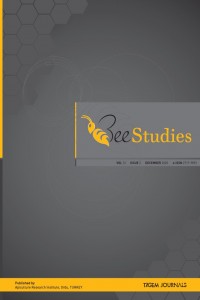Öz
Kaynakça
- Akçay, Ç., Birinci, E., Birinci, C., & Kolaylı, S. (2020). Durability of wood treated with propolis. BioResources, 15(1), 1547-1562.
- Bankova, V., Bertelli, D., Borba, R., Conti, B. J., da Silva Cunha, I. B., Danert, C., ... & Papotti, G. (2019). Standard methods for Apis mellifera propolis research. Journal of Apicultural Research, 58(2), 1-49.
- Benzie I.F.F. ve Strain J.J., 1999. Ferric Reducing/Antioxidant Power Assay: Direct Measure of Total Antioxidant Activity of Biological Fluids and Modified Version for Simultaneous Measurement of Total Antioxidant Power and Ascorbic Acid Concentration, In Methods in Enzymology, 299, 15–27.
- El Adaouia Taleb, R., Djebli, N., Chenini, H., Sahin, H., & Kolayli, S. (2020). In vivo and in vitro anti‐diabetic activity of ethanolic propolis extract. Journal of Food Biochemistry, e13267
- Fukumoto, L.R., Mazza, G.(2000). Assessing antioxidant and prooxidant activities of phenolic compounds.Journal Agriculture Food Chemistry, 48, 3597-3604.
- Galeotti, F., Maccari, F., Fachini, A., & Volpi, N. (2018). Chemical composition and antioxidant activity of propolis prepared in different forms and in different solvents useful for finished products. Foods, 7(3), 41.
- González-Búrquez, M. D. J., González-Díaz, F. R., García-Tovar, C. G., Carrillo-Miranda, L., Soto-Zárate, C. I., Canales-Martínez, M. M., ... & Fonseca-Coronado, S. (2018). Comparison between in vitro antiviral effect of Mexican propolis and three commercial flavonoids against canine distemper virus. Evidence-Based Complementary and Alternative Medicine, 2018.
- Kolayli, S., & Keskin, M. (2020). Natural bee products and their apitherapeutic applications. In Studies in Natural Products Chemistry (Vol. 66, pp. 175-196). Elsevier.
- Oroian, M., Ursachi, F., & Dranca, F. (2020). Influence of ultrasonic amplitude, temperature, time and solvent concentration on bioactive compounds extraction from propolis. Ultrasonics Sonochemistry, 64, 105021.
- Sahin, H. Kemal, M. Antioxidant Capacity of a Bee (2019). Pollen Sample Obtained from Giresun, Turkey. Journal of Apitherapy and Nature. 2, 2, p. 46-51.
- Singleton, V. L.,Rossi, J. A. 1965. Colorimetry of Total Phenolics with Phosphomolybdic-PhosphotungsticAcidReagents. AmericanJournal of EnologyandViticulture, 16: 144-158.
Öz
In this study, quality parameters of some commercially sold in Turkey propolis extracts were compared with freshly prepared ethanolic propolis extract (70%). The pH, total phenolic substance, total flavonoid and total antioxidant capacity values of 11 different commercial samples, including aqueous, ethanolic, water‐based and vegetable oil, were compared. As a result, it was determined that ethanolic samples had the highest activity and the activity of propolis with olive oil was very low. It was found that products with high total polyphenol content (TP) had high total antioxidant values. It was also determined that a standard method was not used for the preparation of commercial propolis samples and that the TP values differ greatly.
Anahtar Kelimeler
Kaynakça
- Akçay, Ç., Birinci, E., Birinci, C., & Kolaylı, S. (2020). Durability of wood treated with propolis. BioResources, 15(1), 1547-1562.
- Bankova, V., Bertelli, D., Borba, R., Conti, B. J., da Silva Cunha, I. B., Danert, C., ... & Papotti, G. (2019). Standard methods for Apis mellifera propolis research. Journal of Apicultural Research, 58(2), 1-49.
- Benzie I.F.F. ve Strain J.J., 1999. Ferric Reducing/Antioxidant Power Assay: Direct Measure of Total Antioxidant Activity of Biological Fluids and Modified Version for Simultaneous Measurement of Total Antioxidant Power and Ascorbic Acid Concentration, In Methods in Enzymology, 299, 15–27.
- El Adaouia Taleb, R., Djebli, N., Chenini, H., Sahin, H., & Kolayli, S. (2020). In vivo and in vitro anti‐diabetic activity of ethanolic propolis extract. Journal of Food Biochemistry, e13267
- Fukumoto, L.R., Mazza, G.(2000). Assessing antioxidant and prooxidant activities of phenolic compounds.Journal Agriculture Food Chemistry, 48, 3597-3604.
- Galeotti, F., Maccari, F., Fachini, A., & Volpi, N. (2018). Chemical composition and antioxidant activity of propolis prepared in different forms and in different solvents useful for finished products. Foods, 7(3), 41.
- González-Búrquez, M. D. J., González-Díaz, F. R., García-Tovar, C. G., Carrillo-Miranda, L., Soto-Zárate, C. I., Canales-Martínez, M. M., ... & Fonseca-Coronado, S. (2018). Comparison between in vitro antiviral effect of Mexican propolis and three commercial flavonoids against canine distemper virus. Evidence-Based Complementary and Alternative Medicine, 2018.
- Kolayli, S., & Keskin, M. (2020). Natural bee products and their apitherapeutic applications. In Studies in Natural Products Chemistry (Vol. 66, pp. 175-196). Elsevier.
- Oroian, M., Ursachi, F., & Dranca, F. (2020). Influence of ultrasonic amplitude, temperature, time and solvent concentration on bioactive compounds extraction from propolis. Ultrasonics Sonochemistry, 64, 105021.
- Sahin, H. Kemal, M. Antioxidant Capacity of a Bee (2019). Pollen Sample Obtained from Giresun, Turkey. Journal of Apitherapy and Nature. 2, 2, p. 46-51.
- Singleton, V. L.,Rossi, J. A. 1965. Colorimetry of Total Phenolics with Phosphomolybdic-PhosphotungsticAcidReagents. AmericanJournal of EnologyandViticulture, 16: 144-158.
Ayrıntılar
| Birincil Dil | İngilizce |
|---|---|
| Konular | Ziraat, Veterinerlik ve Gıda Bilimleri |
| Bölüm | Research Articles |
| Yazarlar | |
| Yayımlanma Tarihi | 31 Aralık 2020 |
| Gönderilme Tarihi | 2 Eylül 2020 |
| Yayımlandığı Sayı | Yıl 2020 Cilt: 12 Sayı: 2 |

